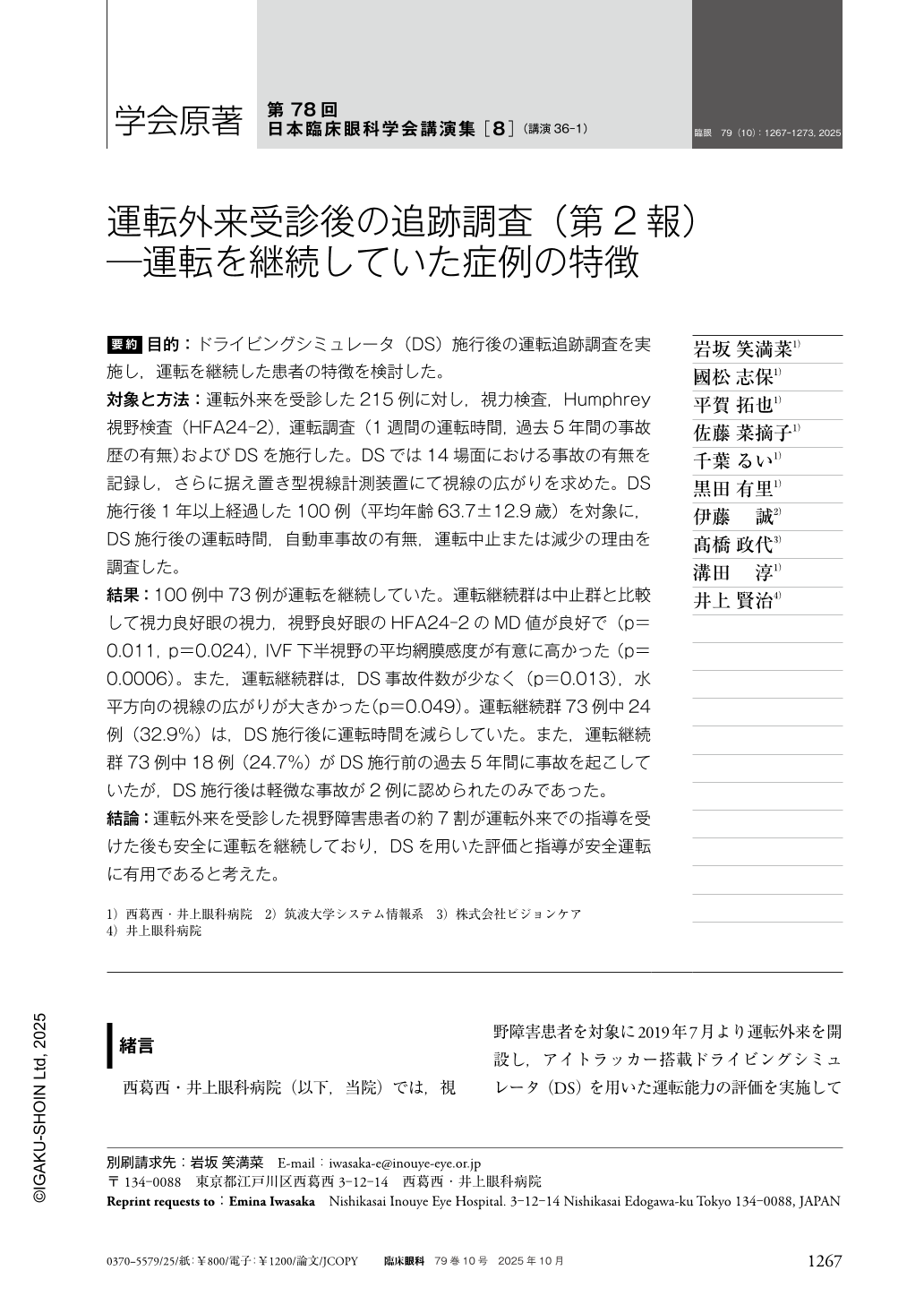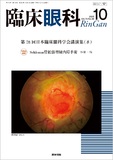Japanese
English
- 有料閲覧
- Abstract 文献概要
- 1ページ目 Look Inside
- 参考文献 Reference
要約 目的:ドライビングシミュレータ(DS)施行後の運転追跡調査を実施し,運転を継続した患者の特徴を検討した。
対象と方法:運転外来を受診した215例に対し,視力検査,Humphrey視野検査(HFA24-2),運転調査(1週間の運転時間,過去5年間の事故歴の有無)およびDSを施行した。DSでは14場面における事故の有無を記録し,さらに据え置き型視線計測装置にて視線の広がりを求めた。DS施行後1年以上経過した100例(平均年齢63.7±12.9歳)を対象に,DS施行後の運転時間,自動車事故の有無,運転中止または減少の理由を調査した。
結果:100例中73例が運転を継続していた。運転継続群は中止群と比較して視力良好眼の視力,視野良好眼のHFA24-2のMD値が良好で(p=0.011,p=0.024),IVF下半視野の平均網膜感度が有意に高かった(p=0.0006)。また,運転継続群は,DS事故件数が少なく(p=0.013),水平方向の視線の広がりが大きかった(p=0.049)。運転継続群73例中24例(32.9%)は,DS施行後に運転時間を減らしていた。また,運転継続群73例中18例(24.7%)がDS施行前の過去5年間に事故を起こしていたが,DS施行後は軽微な事故が2例に認められたのみであった。
結論:運転外来を受診した視野障害患者の約7割が運転外来での指導を受けた後も安全に運転を継続しており,DSを用いた評価と指導が安全運転に有用であると考えた。
Abstract Purpose:To assess the characteristics of drivers with visual field impairment who continue to drive and to investigate the factors associated with continued driving through a follow-up study conducted at a driving assessment clinic.
Methods:A total of 215 patients underwent testing using a driving simulator(DS)(Honda Motor Co.) and the Humphrey Field Analyzer 24-2 SITA-Standard(HFA 24-2) at a driving assessment clinic. Driving history assessed, including weekly driving hours and motor vehicle accidents(MVAs) over the past five years. The integrated visual field(IVF) was calculated based on HFA 24-2 data. Eye movements during the 5-minute DS test were recorded using an eye tracker(Tobii Pro Nano), and the standard deviation of the x-y coordinates was used to assess the horizontal and vertical visual search spread. A follow-up study was conducted on 100 patients(mean age:63.7±12.9 years) who had undergone DS testing more than one year prior at the driving assessment clinic. The follow-up assessment included evaluations of changes in driving hours, MVAs, and reasons for reducing or ceasing driving. The number of collisions in the DS and eye movements during DS testing were recorded, and factors related to driving cessation or continuation were analyzed.
Results:Seventy-three patients(73%) continued to drive. Those who continued to drive had better visual acuity in the eye, better mean deviation(MD), and higher mean IVF sensitivity in the inferior hemifield(p=0.011, p=0.024, and p=0.0006, respectively). They also had fewer DS collisions(p=0.013) and a wider horizontal spread of visual search(p=0.049) than those who ceased driving. Among the 73 patients who continued to drive, 24(32.9%) reported reduced driving hours. Additionally, 18(24.7%) had a history of MVAs in the five years prior to DS testing;however, after undergoing DS assessment, only two minor accidents were reported.
Conclusions:Approximately 70% of patients with visual field impairment who attended a driving assessment clinic continued to drive safely after receiving DS-based evaluation and guidance. These findings suggest that assessment and training at driving assessment clinics may contribute to safer driving among visually impaired individuals.

Copyright © 2025, Igaku-Shoin Ltd. All rights reserved.


